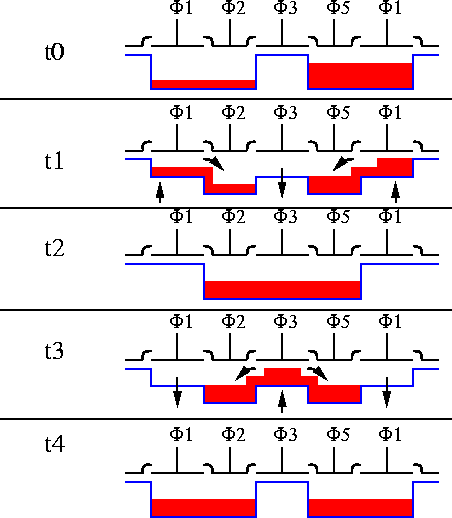The motion detector designed by Lisa
Dron [Dron 93, Dron 94, McIlrath 96] is essentially an edge detection
chip. It uses CCD devices for image acquisition and spatial and
temporal processing of the image. An algorithm called multi-scale veto
(MSV) has been used in the implementation. In MSV a sequence of
spatial smoothing functions are applied to the image. The smoothing
filters have increasing spatial span. An edge is identified when the
difference between contiguous pixels on the edge can pass a threshold
level for all the spatial filters. The main difference between MSV
and other methods, like zero-crossing edge detection, is that the
computation of the second spatial differentiation, i.e. ![]() ,
is not necessary for MSV.
,
is not necessary for MSV.
The implementation of multiple spatial filters is facilitated by clocked CCD circuits. The image information is stored in potential wells, and at each processing cycle is passed through a CCD charge redistribution network, shown in Figure 3.17, which performs a simple spatial averaging. By repeating the cycle, the smoothing function acts over more pixels and widens.
The final fabricated chip contains 32 ![]() 32 detectors on the MOSIS
"LARGE" die size of 7.9mm
32 detectors on the MOSIS
"LARGE" die size of 7.9mm ![]() 9.2mm. The size of each cell is
224
9.2mm. The size of each cell is
224 ![]() 224
224 ![]() . A significant area is dedicated to routing
the clock signals required for operating the CCD circuits. A few
malfunctioning reported in [Dron 94] have been associated
with the poor CCD process used in the implementation.
. A significant area is dedicated to routing
the clock signals required for operating the CCD circuits. A few
malfunctioning reported in [Dron 94] have been associated
with the poor CCD process used in the implementation.

Figure 3.17: The charge redistribution circuit using CCD elements used in
Dron's MSV motion edge detection chip. From top to bottom are the
snapshots of the operation.